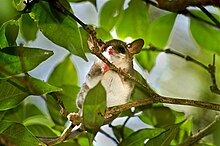Gray slender opossum
Appearance
| Gray slender opossum[1] | |
|---|---|

| |
| Scientific classification | |
| Domain: | Eukaryota |
| Kingdom: | Animalia |
| Phylum: | Chordata |
| Class: | Mammalia |
| Infraclass: | Marsupialia |
| Order: | Didelphimorphia |
| Family: | Didelphidae |
| Genus: | Marmosops |
| Species: | M. incanus
|
| Binomial name | |
| Marmosops incanus (Lund, 1841)
| |

| |
| Gray slender opossum range | |
The gray slender opossum (Marmosops incanus), is an opossum species from Brazil.
This species is a semi-arboreal marsupial, moving on average 67.38% on the ground.[3] They are solitary, nocturnal, and scansorial (tree climbers).[4] They live off a diet of mainly insects.[5]
References
Wikimedia Commons has media related to Marmosops incanus.
- ^ Gardner, A. (2005). Wilson, D.E.; Reeder, D.M. (eds.). Mammal Species of the World: A Taxonomic and Geographic Reference (3rd ed.). Johns Hopkins University Press. p. 11. ISBN 978-0-8018-8221-0. OCLC 62265494.
- ^ Brito, D.; Astúa, D.; Lew, D.; Soriano, P.; Emmons, L. (2021). "Marmosops incanus". IUCN Red List of Threatened Species. 2021: e.T12822A197313574. doi:10.2305/IUCN.UK.2021-1.RLTS.T12822A197313574.en. Retrieved 12 November 2021.
- ^ Loretto, Diogo; Vieira, Marcus Vinícius (July 2008). "Use of space by the marsupial Marmosops incanus (Didelphimorphia, Didelphidae) in the Atlantic Forest, Brazil". Mammalian Biology. 73 (4): 255–261. doi:10.1016/j.mambio.2007.11.015. ISSN 1616-5047.
- ^ Semedo, Thiago Borges Fernandes; Rossi, Rogério Vieira; Júnior, Tarcísio S. Santos (2013-01-01). "New records of the Spectacled Slender Opossum Marmosops ocellatus (Didelphimorphia, Didelphidae) with comments on its geographic distribution limits". Mammalia. 77 (2). doi:10.1515/mammalia-2012-0072. ISSN 1864-1547. S2CID 84602782.
- ^ da Fonseca, Gustavo A.B. (1985). "The vanishing Brazilian Atlantic forest". Biological Conservation. 34 (1): 17–34. doi:10.1016/0006-3207(85)90055-2. ISSN 0006-3207.

